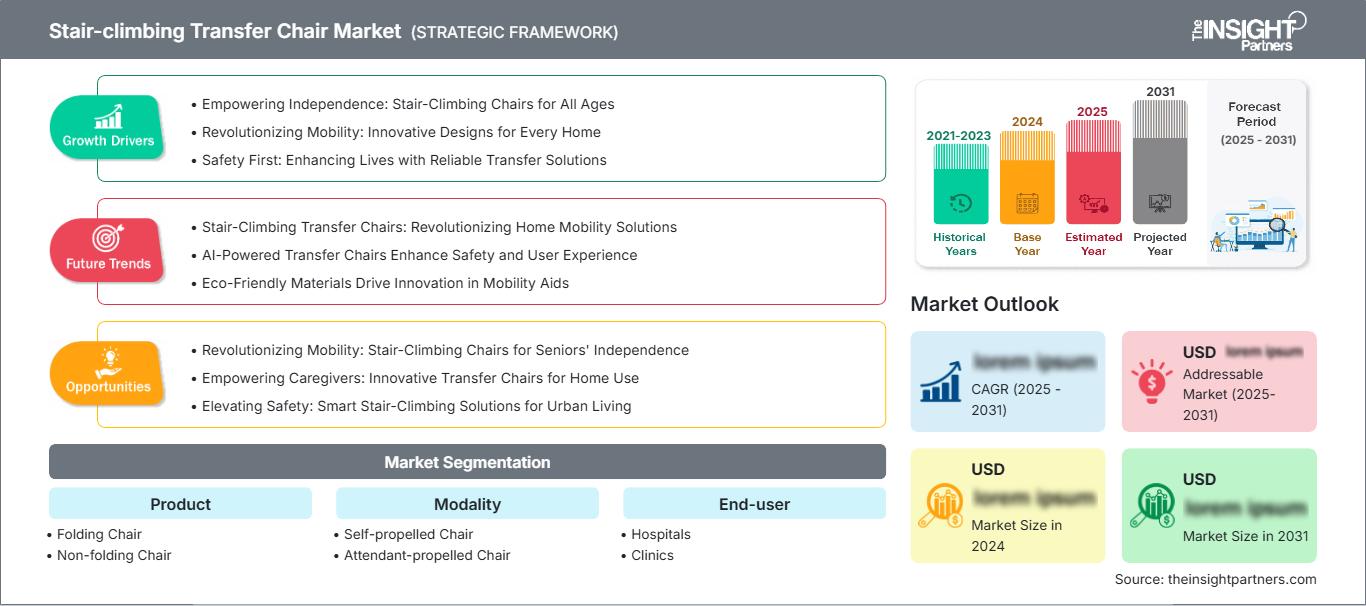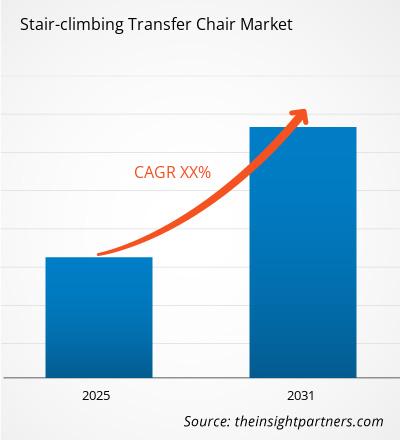Si prevede che il mercato delle sedie da trasferimento per salire le scale registrerà una crescita costante dal 2026 al 2034, con una valutazione prevista in crescita rispetto al valore di riferimento del 2025 e in un'espansione sostenuta fino alla fine del periodo di previsione. Questa tendenza riflette una prospettiva di mercato favorevole, guidata dall'evoluzione dei requisiti del settore e dai continui progressi tecnologici.
Il rapporto è suddiviso per prodotto (sedia pieghevole, sedia non pieghevole) e analizza ulteriormente il mercato in base alla modalità (sedia autospinta, sedia con assistente). Esamina inoltre il mercato per utente finale (ospedali, cliniche). Viene fornita una ripartizione completa a livello globale, regionale e nazionale per ciascuno di questi segmenti chiave. Il rapporto include dimensioni e previsioni di mercato per tutti i segmenti, presentando i valori in USD. Fornisce inoltre statistiche chiave sullo stato attuale del mercato dei principali attori, insieme ad approfondimenti sulle tendenze prevalenti e sulle opportunità emergenti.
Scopo del rapporto
Il rapporto "Stair-climbing Transfer Chair Market" di The Insight Partners mira a descrivere il panorama attuale e la crescita futura, i principali fattori trainanti, le sfide e le opportunità. Ciò fornirà spunti a vari stakeholder aziendali, come:
- Fornitori/Produttori di tecnologia: per comprendere le dinamiche di mercato in evoluzione e conoscere le potenziali opportunità di crescita, consentendo loro di prendere decisioni strategiche informate.
- Investitori: per condurre un'analisi completa delle tendenze in merito al tasso di crescita del mercato, alle proiezioni finanziarie di mercato e alle opportunità esistenti lungo la catena del valore.
- Enti di regolamentazione: per regolamentare le politiche e le attività di controllo sul mercato con l'obiettivo di ridurre al minimo gli abusi, preservare la fiducia degli investitori e sostenere l'integrità e la stabilità del mercato.
Segmentazione del mercato delle sedie da trasferimento per salire le scale Prodotto
- Sedia pieghevole
- Sedia non pieghevole
Modalità
- Sedia semovente
- Sedia a propulsione assistita
Utente finale
- Ospedali
- Cliniche
Potrai personalizzare gratuitamente qualsiasi rapporto, comprese parti di questo rapporto, o analisi a livello di paese, pacchetto dati Excel, oltre a usufruire di grandi offerte e sconti per start-up e università
Mercato delle sedie da trasferimento per salire le scale: Approfondimenti strategici

-
Ottieni le principali tendenze chiave del mercato di questo rapporto.Questo campione GRATUITO includerà l'analisi dei dati, che vanno dalle tendenze di mercato alle stime e alle previsioni.
Fattori di crescita del mercato delle sedie da trasferimento per salire le scale
- Potenziare l'indipendenza: sedie da trasferimento per tutte le età
- Rivoluzionare la mobilità: design innovativi per ogni casa
- La sicurezza prima di tutto: migliorare la vita con soluzioni di trasferimento affidabili
Tendenze future del mercato delle sedie da trasferimento per salire le scale
- Sedie da trasferimento per salire le scale: rivoluzionare le soluzioni di mobilità domestica
- Le sedie da trasferimento basate sull'intelligenza artificiale migliorano la sicurezza e l'esperienza dell'utente
- I materiali ecocompatibili guidano l'innovazione negli ausili per la mobilità
Opportunità di mercato delle sedie da trasferimento per salire le scale
- Rivoluzionare la mobilità: sedie da trasferimento per l'indipendenza degli anziani
- Potenziare Assistenti: sedie da trasferimento innovative per uso domestico
- Sicurezza elevata: soluzioni intelligenti per salire le scale nella vita urbana
Mercato delle sedie da trasferimento per salire le scale
Le tendenze regionali e i fattori che influenzano il mercato delle sedie per il trasporto su scale durante il periodo di previsione sono stati ampiamente spiegati dagli analisti di The Insight Partners. Questa sezione illustra anche i segmenti di mercato e la geografia della gestione delle malattie del ritmo cardiaco in Nord America, Europa, Asia-Pacifico, Medio Oriente e Africa, America meridionale e centrale.
Mercato delle sedie da trasferimento per salire le scale Report Scope
| Attributo del rapporto | Dettagli |
|---|---|
| Dimensioni del mercato in 2025 | US$ XX Million |
| Dimensioni del mercato per 2034 | US$ XX Million |
| CAGR globale (2026 - 2034) | XX% |
| Dati storici | 2021-2024 |
| Periodo di previsione | 2026-2034 |
| Segmenti coperti |
By Prodotto
|
| Regioni e paesi coperti |
Nord America
|
| Leader di mercato e profili aziendali chiave |
|
Densità degli operatori del mercato delle sedie da trasferimento per salire le scale: comprendere il suo impatto sulle dinamiche aziendali
Il mercato delle sedie per il trasporto su scale è in rapida crescita, trainato dalla crescente domanda degli utenti finali, dovuta a fattori quali l'evoluzione delle preferenze dei consumatori, i progressi tecnologici e una maggiore consapevolezza dei vantaggi del prodotto. Con l'aumento della domanda, le aziende stanno ampliando la propria offerta, innovando per soddisfare le esigenze dei consumatori e sfruttando le tendenze emergenti, alimentando ulteriormente la crescita del mercato.

- Ottieni il Mercato delle sedie da trasferimento per salire le scale Panoramica dei principali attori chiave
Punti di forza
- Copertura completa: il rapporto analizza in modo completo prodotti, servizi, tipologie e utenti finali del mercato delle sedie da trasferimento per salire le scale, fornendo una panoramica olistica.
- Analisi degli esperti: il rapporto è compilato sulla base della conoscenza approfondita di esperti e analisti del settore.
- Informazioni aggiornate: il rapporto garantisce rilevanza aziendale grazie alla copertura di informazioni e tendenze dei dati recenti.
- Opzioni di personalizzazione: questo rapporto può essere personalizzato per soddisfare le esigenze specifiche del cliente e adattarsi in modo appropriato alle strategie aziendali.
Il rapporto di ricerca sul mercato delle sedie da trasferimento per salire le scale può quindi aiutare a guidare il percorso di decodificazione e comprensione dello scenario del settore e delle prospettive di crescita. Sebbene possano esserci alcune preoccupazioni valide, i vantaggi complessivi di questo rapporto tendono a superare gli svantaggi.
- Analisi storica (2 anni), anno base, previsione (7 anni) con CAGR
- Analisi PEST e SWOT
- Valore/volume delle dimensioni del mercato - Globale, Regionale, Nazionale
- Industria e panorama competitivo
- Set di dati Excel
Report recenti
Rapporti correlati
Testimonianze
Motivo dell'acquisto
- Processo decisionale informato
- Comprensione delle dinamiche di mercato
- Analisi competitiva
- Analisi dei clienti
- Previsioni di mercato
- Mitigazione del rischio
- Pianificazione strategica
- Giustificazione degli investimenti
- Identificazione dei mercati emergenti
- Miglioramento delle strategie di marketing
- Aumento dell'efficienza operativa
- Allineamento alle tendenze normative






















 Ottieni un campione gratuito per - Mercato delle sedie da trasferimento per salire le scale
Ottieni un campione gratuito per - Mercato delle sedie da trasferimento per salire le scale